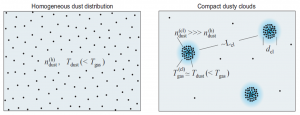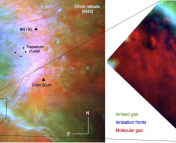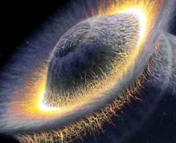Title: Compact Dusty Clouds and Efficient H2 Formation in Diffuse ISM
Authors: A. V. Ivlev, A. Burkert, A. Vasyunin, and P. Caselli
First Author’s Institution: Max-Planck-Institut für Extraterrestrische Physik, 85748 Garching, Germany
Status: Accepted to The Astrophysical Journal [open access]
An element of epic proportions

Figure 1: A filament of the Taurus Molecular Cloud, which contains both (1) stars that are newly formed and (2) stars that have yet to form. Image Credit: ESO/APEX (MPIfR/ESO/OSO)/A. Hacar et al./Digitized Sky Survey 2. Acknowledgment: Davide De Martin.
The simplest known element in the universe, hydrogen, is also the most important. Hydrogen (aka “H”) plays a crucial role for many of the awesome astrophysical phenomena that have happened (and will happen!) across the universe’s history. This element fuses in the cores of stars, lights up ionized regions in supernova remnants, and serves as a building block for other elements in the periodic table – just to name a few of its many talents.
But that’s not all this epic element can do! Its molecular form, H2, is the primary ingredient for molecular clouds, like the one shown in Figure 1. These molecular clouds are made up of both gas and dust grains. They are often found within spiral galaxies (like our own Milky Way), and they’re interesting in part because they’re the only known sites where glorious star formation occurs.
To better understand molecular clouds and their glorious star formation, scientists have long studied the timescales for these clouds to form within the less dense, diffuse interstellar medium (a collective term for all of the matter and radiation between star systems) of space.
Classic calculations of these timescales have often assumed that the diffuse interstellar medium (aka, ISM) is pretty homogeneous, even when we zoom in. In other words, they assumed that the gas and dust in the diffuse ISM are spread out uniformly, so that every bit of the diffuse ISM looks the same as every other bit. But observations from the last 50 years or so indicate that the diffuse ISM is actually very not homogeneous, with lumps and bumps even across small (relatively speaking) Solar System-sized regions.
There have been numerous studies on what could be causing this non-uniformity at such small scales. But today’s authors look at a possible mechanism that is particularly significant for H2: the formation of tightly-packed dusty clouds and equilibrium gaseous clumps in the diffuse ISM. We’ll dive into what these clouds and clumps are made of in the next section.
Forming clouds and clumps
The authors discuss 2 main bits of physics that could form these aptly-named dusty clouds and gaseous clumps:
Major Physics #1: Attractive shadowing forces between dust grains in the diffuse ISM. These mysterious-sounding forces refer to the collective interactions that can happen between dust grains within a gas. In the diffuse interstellar medium, these forces are attractive: they pull the dust grains towards each other like little magnets, gathering them together into dusty clouds within the diffuse ISM: tightly-packed (aka, compact) dust grains with gas squeezed in between the grains.
Major Physics #2: Efficient thermal coupling between the dust and gas within these dusty clouds. The fancy term in italics here basically means that the gas within a dusty cloud adapts the same temperature as the dust within the dusty cloud. But the temperature of the dust within the cloud, Tdust, is lower than the temperature of the gas outside the cloud, Tgas. That means the gas within the cloud decreases in temperature from Tgas to Tdust; to do that (without breaking the laws of physics), the gas within the cloud also increases in density relative to the gas outside of the cloud. Then we end up with a gaseous clump within and just around the dusty cloud: gas squeezed into the space between the dust grains that is denser than the gas outside of the dusty cloud.

Figure 2: Illustrations of the diffuse ISM, if the diffuse ISM was actually homogeneous (left panel) and if the diffuse ISM formed compact dusty clouds (right panel). On the left, we see that the dust (the black dots) and the gas (the pale blue background) are pretty uniformly distributed across the medium. The temperature of the dust grains (Tdust) is smaller than the temperature of the gas (Tgas). On the right, we see dust (again the black dots) has gathered together to form dusty clouds, which are much denser than dust in the surrounding diffuse ISM. The gas has also gathered in gaseous clumps (shaded in dark blue) within and around the edges of the dusty clouds. Here the temperature of the gas within the dusty clouds is about equal to that of the dust within the dusty clouds (Tgas(cl)), and both temperatures are smaller than the temperature of the surrounding gas (still Tgas). From Figure 2 in the paper.
By these two physics processes, we end up with diffuse ISM that is studded with compact dusty clouds/gaseous clumps, as illustrated in Figure 2.
It all comes together
With these dusty clouds embedded within, the diffuse ISM is definitely not homogeneous. This means that the chemistry happening within the diffuse ISM is also not homogeneous, and will unfold differently for the dusty clouds than it will for the surrounding diffuse ISM.
The authors derived how the rate of H2 formation would change due to these dusty clouds and equilibrium gaseous clumps. They found that the new rate of formation, compared to the rate if the diffuse ISM was actually homogeneous, increases by a factor ranging from about ~5 to ~10 for typical gas and dust temperatures.
For the typical diffuse ISM values that the authors explored, this increased rate means that the transition from H to molecular H2 in the diffuse ISM could happen in just a few million years. The authors point out that this reduced timescale has wide astrophysical applications… but first and foremost, it affects how we expect giant molecular clouds, and thus their glorious star formation, to physically evolve. The faster transition from H to H2 could also affect other chemical species in the diffuse ISM, not just our epic element hydrogen. But we’ll need more investigation to see for sure!




